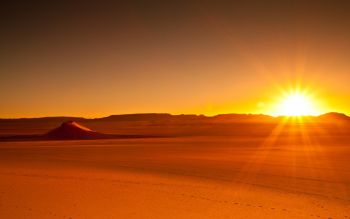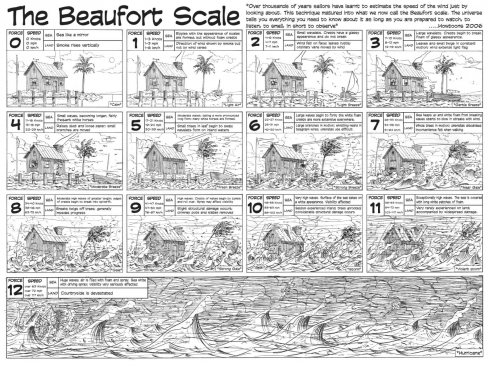Control Weather (spell)
| Grade | °C | °F |
|---|---|---|
| polar | -40 or less | -40 or less |
| arctic | -35 to -39 | -30 to -39 |
| bitterly cold | -29 to -34 | -20 to -29 |
| very cold | -24 to -28 | -10 to -19 |
| cold | -18 to -23 | 0 to -9 |
| wintry | -12 to -17 | 1 to 9 |
| icy | -7 to -11 | 10 to 19 |
| frosty | -2 to -6 | 20 to 29 |
| chilly | -1 to 4 | 30 to 39 |
| brisk | 5 to 9 | 40 to 49 |
| cool | 10 to 15 | 50 to 59 |
| pleasant | 16 to 21 | 60 to 69 |
| warm | 22 to 26 | 70 to 79 |
| balmy | 27 to 32 | 80 to 89 |
| sweaty | 33 to 37 | 90 to 99 |
| sweltering | 38 to 43 | 100 to 109 |
| feverish | 44 to 48 | 110 to 119 |
| baking | 49 to 54 | 120 to 129 |
| scorching | 55 or more | 130 or more |
| Range | self |
| Duration | 4-48 hours |
| Area of Effect | 3⅓ mile radius |
| Casting Time | 3 rounds |
| Saving Throw | none |
| Level | cleric (7th); druid (7th) |
Allows the cleric to change the conditions and wind force of the locality, depending upon the previous conditions. This effect will cover an area equal to seven 2-mile hexes, or one 6-mile hex. At the edge of the adjustment will be a distinct, observable barrier about 20 yards thick, that anyone can pass through. The change will be startling, especially as most who encounter this barrier will have no knowledge of the caster's presence or the reason how this strange phenomenon is. Nevertheless, the spell will preclude the possibility that anyone beneath 5th level of giving the matter much attention, while only those above 10 level would find it something worth investigating.
The caster must make adjustments to the temperature, the wind force and the weather.
Change in Temperature
The Temperature Grades table provides a translation of each temperature description into degrees Celsius or Fahrenheit; these descriptions exist because no actual scale exists as a measurement in the 17th century game world. The caster may reduce or increase the relative temperature no more than two grades. For example, "baking" could be reduced to merely "sweltering," or sweltering could be reduced to "balmy."
An adjustment of 12-20 degrees Fahrenheit can have a remarkable effect upon the character's relative comfort. The DM can provide some game colour to the process, stressing details of how the players feel as the spell takes effect.
The adjustment in temperature requires 10-40 rounds (10d4), or between 2 and 8 minutes. During the change, characters wearing too much clothing or not enough will need to adjust their CLO progressively, particularly if the change in temperature is occurring during combat. Likewise, there will be a noticeable change in the texture and hardness of ice, particularly if the temperature change brings the surrounding weather from below zero to above. Free ice will begin to become slick almost within 4-10 rounds, as the ice surface turns to water.
Once the change in temperature, the caster will need to consider what sort of weather is desired.
Conditions
| Grades | possible conditions |
|---|---|
| polar to icy | blizzard, clear, cloudy, flakes (very light snow), flurries, low clouds (100 ft. ceiling), overcast |
| frosty or chilly | clear, cloudy, flakes, flurries, fog (light to heavy), ice storm, low clouds, mist (freezing or chill), overcast, sleet |
| brisk or cool | clear, cloudy, drizzle, fog (light), low clouds, overcast, showers |
| pleasant to sweltering | clear, cloudy, overcast, showers, sunny, threatening clouds, thunderstorm (and hurricane in special conditions) |
| feverish to scorching | clear, cloudy, overcast, showers, sunny |
Within the parameters on the atmospheric conditions table, the caster may specify the cloud cover, the amount of precipitation and what form that precipitation will take. For example, if the temperature is either "brisk" or "cool," then there are seven forms of weather that might be selected, ranging from "clear" to "showers." Only conditions specific to the temperature grade may be chosen; for example, a hurricane could not take place during polar weather. A blizzard might produce hurricane-force winds, but it would still have the characteristics of a blizzard.
Details regarding these conditions are explained on these links:
"Storms" presume a great deal of wind. If wind is minimal, then precipitation falls as "rain" or "snow." "Ice storms" aren't storms in the traditional sense.
Hurricanes are storms that can occur only under special circumstances. The spell cannot be used to form them adjacent to the land, since meteorologically the conditions near land are not sufficient to produce the pressure needed. Hurricanes form in the ocean. Additionally, it must be done within the Tropics of Cancer and Capricorn, where the ocean water is sufficiently warm. Under those conditions, however, the caster may create a small hurricane that will dissipate at the end of the spell duration.
Wind Force
| Conditions | Wind Force min/max |
|---|---|
| blizzard | 7 to 11 |
| clear | 0 to 6 |
| cloudy | 0 to 5 |
| drizzle | 0 to 3 |
| flakes | 0 to 3 |
| flurries | 3 to 6 |
| fog (light) | 0 to 1 |
| fog (moderate/heavy) | 0 |
| hurricane | 12 |
| ice storm | 0 to 1 |
| low clouds | 0 to 1 |
| mist (chill) | 0 to 2 |
| mist (freezing) | 1 to 2 |
| overcast | 3 to 6 |
| showers | 2 to 7 |
| sleet | 3 to 6 |
| sunny | 0 to 2 |
| threatening clouds | 5 to 10 |
| thunderstorm | 6 to 11 |
Knowing the conditions, the caster can now select the wind force desired. The diagram provides context beyond what the wind speed can provide. The smaller the number chosen, the calmer and more charming the weather will be. Forces 0-2 are considered "nice" weather, being still or airy. Forces 3 to 5 are "breezy," being lovely and enjoyable for a walk or to lay outside. Forces 6 to 7 are blustery, with large branches or whole trees in motion, making it difficult to walk. Damage to property begins with Force 8, a "gale;" Force 10 will uproot trees; Force 11 will tear away roofs; and Force 12 is a hurricane.
Any significant alteration to the wind force of 4 degrees or more will produce either an unnatural calm or sudden appearance in wind. If this is done during a combat, then everyone in the battle must make a panic check immediately.
Those who fail will break and retreat until rallied.

